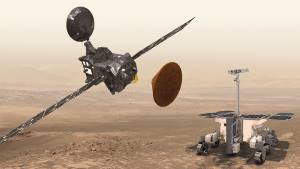ExoMars

Artist's illustration of ExoMars' Trace Gas Orbiter (left), Schiaparelli lander (middle), and rover (right)
|
|
| Mission type | Mars reconnaissance |
|---|---|
| Operator | ESA · RFSA |
| Website |
exploration exomars |
| Mission duration | Elapsed: 10 months and 20 days |
 ExoMars ESA mission insignia |
|
ExoMars (Exobiology on Mars) is a two-part Martian astrobiology project to search for evidence of life on Mars, a joint mission of the European Space Agency (ESA) and the Russian space agency Roscosmos. The first part, launched in 2016, placed a trace gas research and communication satellite into Mars orbit and released a stationary experimental lander (which crashed). The second part is planned to launch in 2020, and to land a rover on the surface, supporting a science mission that is expected to last into 2022 or beyond.
ExoMars goals are to search for signs of past and present life on Mars, investigate how the Martian water and geochemical environment varies, investigate atmospheric trace gases and their sources and by doing so demonstrate the technologies for a future Mars sample return mission. The mission will search for biosignatures of Martian life, past or present, employing several spacecraft elements to be sent to Mars on two launches.
The ExoMars Trace Gas Orbiter (TGO) and a test stationary lander called Schiaparelli were launched on 14 March 2016. TGO entered Mars orbit on 19 October 2016 and will proceed to map the sources of methane (CH
4) and other trace gases present in the Martian atmosphere that could be evidence for possible biological or geological activity. The Schiaparelli experimental lander separated from TGO on 16 October and was maneuvered to land in Meridiani Planum. As of 19 October 2016[update], ESA had not received a signal that the landing was successful. On 21 October 2016, NASA released a Mars Reconnaissance Orbiter image showing what appears to be the lander crash site. The landing was designed to test new key technologies to safely deliver the 2020 rover mission. The TGO features four instruments and will also act as a communications relay satellite.
...
Wikipedia
